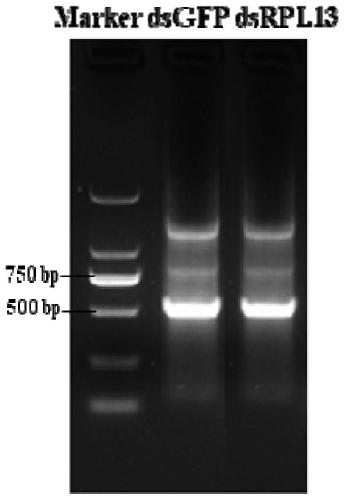Henosepilachna vigintioctopunctata high lethal gene and application thereof to controlling henosepilachna vigintioctopunctata
A 28 star lady beetle, gene technology, applied in the application, genetic engineering, plant genetic improvement and other directions, can solve the problem of no insecticidal activity, no research on the gene function of the 28 star lady beetle, etc., to achieve effective The effect of good performance and sensitivity, environmental friendliness and convenient operation
- Summary
- Abstract
- Description
- Claims
- Application Information
AI Technical Summary
Problems solved by technology
Method used
Image
Examples
Embodiment 1
[0033] Obtaining of synthetic dsRNA of embodiment 1 gene RPL13 kit
[0034]We constructed the transcriptome library based on the genome of the ladybug Solanum solani, and then based on the constructed transcriptome library, researched and screened the genes related to the growth and development of the ladybug Solanum, screened the RPL13 gene, and based on the RACE (rapid -amplification of cDNA ends) technology to amplify the full-length CDS sequence of the RPL13 gene, and the kit used by RACE is from TAKARA company ( RACE 5’ / 3’Kit cat#634858), the experimental steps are detailed in the kit instructions. The primers for 5'RACE and 3'RACE were designed as P7 and P8 in Primer Table 1. The kits used for the PCR reaction and cloning involved in the RACE process are as described above, and the CDS sequence of the RPL13 gene was obtained from the sequencing results, as shown in SEQ ID NO.1. The dsRNA is subsequently synthesized based on the sequence information.
[0035] 1. Extra...
Embodiment 2
[0050] Obtaining of embodiment 2 gene RPL13 bacterium expressing dsRNA
[0051] 1. Construction of dsRPL13 and L4440 expression vectors
[0052] Two restriction sites were selected on the sequence of L4440, namely BamHI (GGATCC) and SacI (GAGCTC). According to the sequence information of L4440 (this sequence information has been made public), add the homology arms related to the two restriction sites to the primer P1 of dsRPL13 and the primer P2 of dsGFP respectively, and design the primer P3 related to the construction of expression vector of dsRPL13 , Primer P4 (Table 1) related to construction of expression vector for dsGFP. Using the cDNA in Example 2 as a template, the reaction system and amplification program of PCR amplification are as shown in Example 2, and the target fragments of dsRPL13 and dsGFP of the construction vector are obtained, and the DNA purification recovery kit (Universal DNA Purification Kit) is used , TIANGEN) recovered the two PCR products obtained...
Embodiment 3
[0055] Example 3 Application of dsRNA in Inhibiting the Growth and Development of Ladybug Solanum
[0056] 1. Preparation of host plants and artificial incubators for ladybird solanum
[0057] The eggplant variety fed with eggplant twenty-eight star ladybird is Wansheng Marshal round eggplant seedlings, and the artificial incubator is a 90mm petri dish with filter paper and humidified cotton balls.
[0058] 2. The application of artificially synthesized dsRPL13 in inhibiting the growth and development of Ladybug solani
[0059] RPL13 dsRNA feeding group (dsRPL13): 10 1st instar larvae of Ladybug solani were placed in a petri dish with filter paper and humidified cotton balls. Soak round eggplant leaves with a diameter of 12 mm in dsRPL13 solutions with a concentration of 10 ng / μL, 50 ng / μL, 100 ng / μL, 250 ng / μL and 500 ng / μL for 1 min, air-dry them at room temperature for 1 h, and then feed the larvae, and replace the leaf discs every 24 h , after two days of continuous feed...
PUM
 Login to View More
Login to View More Abstract
Description
Claims
Application Information
 Login to View More
Login to View More - R&D
- Intellectual Property
- Life Sciences
- Materials
- Tech Scout
- Unparalleled Data Quality
- Higher Quality Content
- 60% Fewer Hallucinations
Browse by: Latest US Patents, China's latest patents, Technical Efficacy Thesaurus, Application Domain, Technology Topic, Popular Technical Reports.
© 2025 PatSnap. All rights reserved.Legal|Privacy policy|Modern Slavery Act Transparency Statement|Sitemap|About US| Contact US: help@patsnap.com



